Maintaining your vacuum is essential for ensuring it performs at its best. A key component of this upkeep is keeping the filters clean and replacing them when needed. Filters trap dust, dirt, and allergens, keeping your home clean and fresh.
If filters are neglected, your vacuum’s suction power decreases, and its ability to clean efficiently drops. In this article, we will cover how to clean and replace your vacuum filters to maintain peak performance.
Why Is Filter Maintenance Important?
The filter is the heart of your vacuum’s cleaning system. It traps dirt and dust particles, preventing them from being released back into the air. Over time, filters can become clogged with debris, reducing the vacuum’s effectiveness. Clogged filters also force the vacuum to work harder, potentially shortening its lifespan.
By regularly cleaning or replacing filters, you keep the vacuum’s suction strong and maintain good indoor air quality. This is especially important for those with allergies or respiratory issues, as a dirty filter can recirculate allergens back into the air.
Types of Vacuum Filters
Understanding the type of filter in your vacuum is crucial. There are several common types:
1. HEPA Filters
HEPA (High-Efficiency Particulate Air) filters are designed to trap even the smallest particles, including allergens. These filters are ideal for homes with pets or individuals who suffer from allergies. However, HEPA filters need regular cleaning or replacement to remain effective.
2. Foam Filters
Foam filters are commonly found in many vacuums and are often washable. These filters are highly durable but must be cleaned frequently to maintain suction power.
3. Cartridge Filters
Cartridge filters are usually made of pleated paper and can trap a large amount of dust. Some are washable, while others need replacement after a certain period.
4. Cloth Filters
Cloth filters are reusable and washable. They’re common in larger vacuum models and can last a long time with proper maintenance.
How Often Should You Clean or Replace Filters?
The frequency of filter cleaning and replacement depends on several factors:
- Vacuum Usage: If you use your vacuum daily, the filter will need more frequent attention.
- Home Environment: Homes with pets, lots of foot traffic, or dusty areas will require more frequent filter maintenance.
- Filter Type: Some filters, like HEPA filters, may need to be replaced more often, while foam filters can be washed and reused.
Generally, it’s recommended to clean filters every 1 to 3 months. HEPA filters might need replacing every 6 to 12 months, depending on the manufacturer’s instructions and usage level.
Steps to Properly Clean Vacuum Filters
Cleaning your vacuum filters is a simple process but requires attention to detail. Follow these steps to ensure proper cleaning:
1. Turn Off and Unplug the Vacuum
Safety first. Always ensure the vacuum is turned off and unplugged before handling any internal parts like filters.
2. Remove the Filter
Locate the filter in your vacuum. Most vacuums have a compartment where the filter is easily accessible. Refer to the vacuum’s manual if you’re unsure.
3. Shake Off Loose Debris
Gently tap the filter against a trash bin to remove loose dirt and debris. This is a good first step before you proceed to a more thorough cleaning.
4. Wash (If Washable)
If your filter is washable, rinse it under lukewarm water. Avoid using soap unless specified by the manufacturer, as this can damage certain filters. Make sure to wash both sides of the filter, ensuring all dust is removed.
5. Air Dry Completely
Allow the filter to air dry completely before placing it back in the vacuum. This can take anywhere from 24 to 48 hours. Never put a wet filter back into the vacuum, as this can damage the machine.
6. Reinsert the Filter
Once the filter is completely dry, reinsert it into the vacuum, ensuring it is securely in place.
When to Replace Vacuum Filters
While many filters are washable, some eventually need replacement to ensure peak performance. Here are signs it’s time to replace your vacuum’s filter:
- Loss of Suction: If your vacuum isn’t picking up dirt as efficiently as before, the filter may be clogged beyond repair.
- Visible Damage: Torn or damaged filters will no longer trap dust effectively.
- Persistent Odors: If cleaning the filter doesn’t remove odors, it may be time for a new one.
- Manufacturer’s Recommendation: Always follow the manufacturer’s guidelines for filter replacement. Some vacuums require new filters every 6 to 12 months.
Maintaining Your Vacuum for Optimal Performance
Cleaning and replacing filters is just one part of keeping your vacuum in top condition. Regularly check the vacuum’s brush roll, hoses, and other components for blockages or wear. Proper maintenance ensures that your vacuum will last longer and perform better.
For those who use robot vacuums, filter maintenance is still essential. These vacuums are equipped with similar filtration systems that require the same level of care. Regularly cleaning and replacing filters in robot vacuums ensures they can navigate your home efficiently and keep your floors clean.
Conclusion
Keeping your vacuum’s filters clean and replacing them when necessary is key to ensuring it operates at peak performance. By following the proper steps and staying on top of maintenance, you’ll extend the life of your vacuum and maintain a healthier home environment.
Don’t overlook the importance of filter care, as it not only improves your vacuum’s suction but also the quality of the air in your home. So, make sure to give your vacuum the attention it deserves!




